Business Law Assignment: Contract Law Case Study Analysis
VerifiedAdded on 2023/01/11
|6
|1699
|85
Case Study
AI Summary
This case study analyzes the contract law dispute between Lee Auctioneers and Mrs. Grace Richards, focusing on the formation and enforceability of a contract during an auction. The assignment explores the elements of a valid contract, including offer and acceptance, in the context of property sales. It differentiates between an offer and an invitation to treat, examining the factors that influence the court's decision. The document also outlines conditions for contract termination, including impossibility, fraud, and breach, as well as circumstances that can render a contract unenforceable, such as lack of capacity or illegal terms. The analysis concludes with an assessment of the potential court ruling, considering the reserve price and the highest bid. The assignment provides a comprehensive overview of contract law principles, relevant legal concepts, and the practical application of these principles in a real-world scenario.
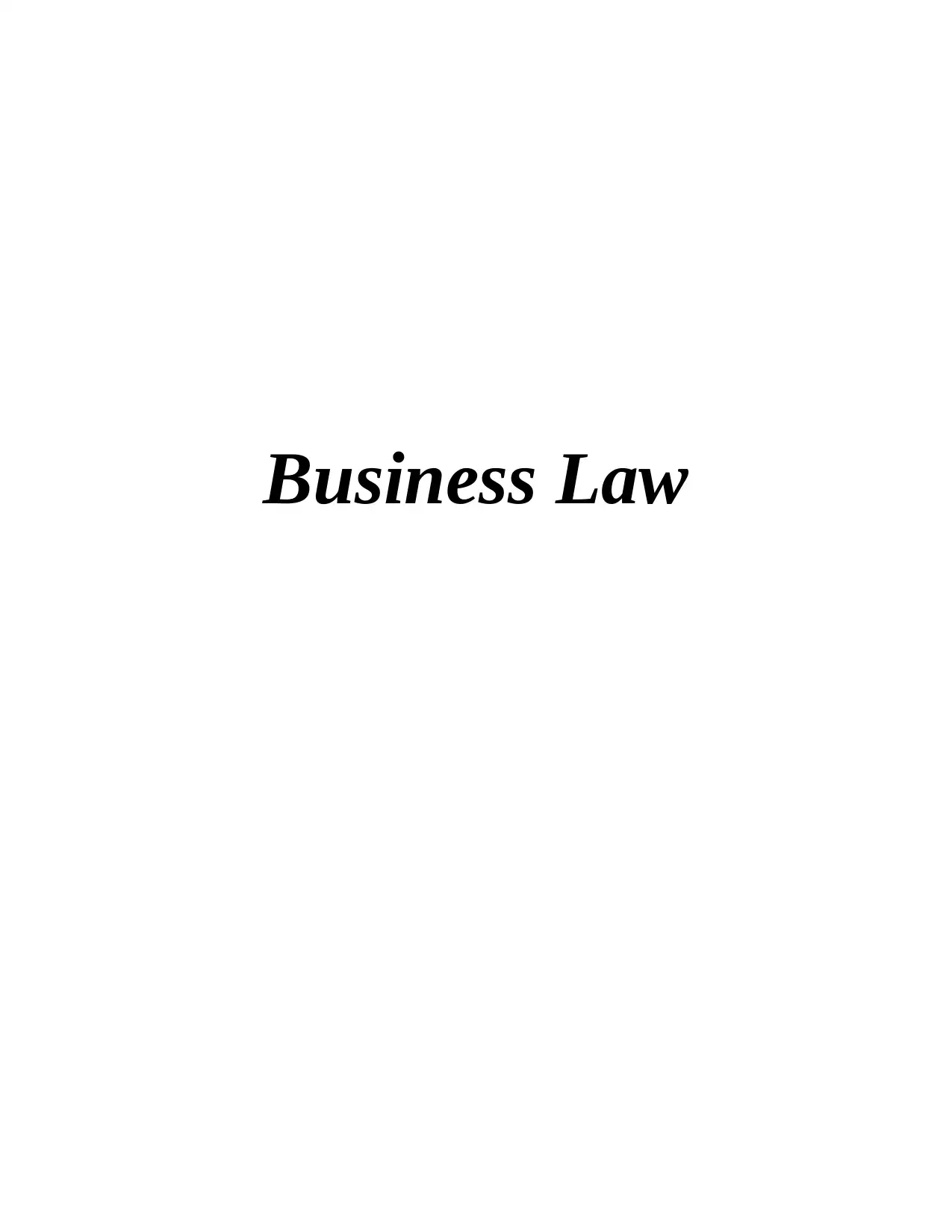
Business Law
Paraphrase This Document
Need a fresh take? Get an instant paraphrase of this document with our AI Paraphraser
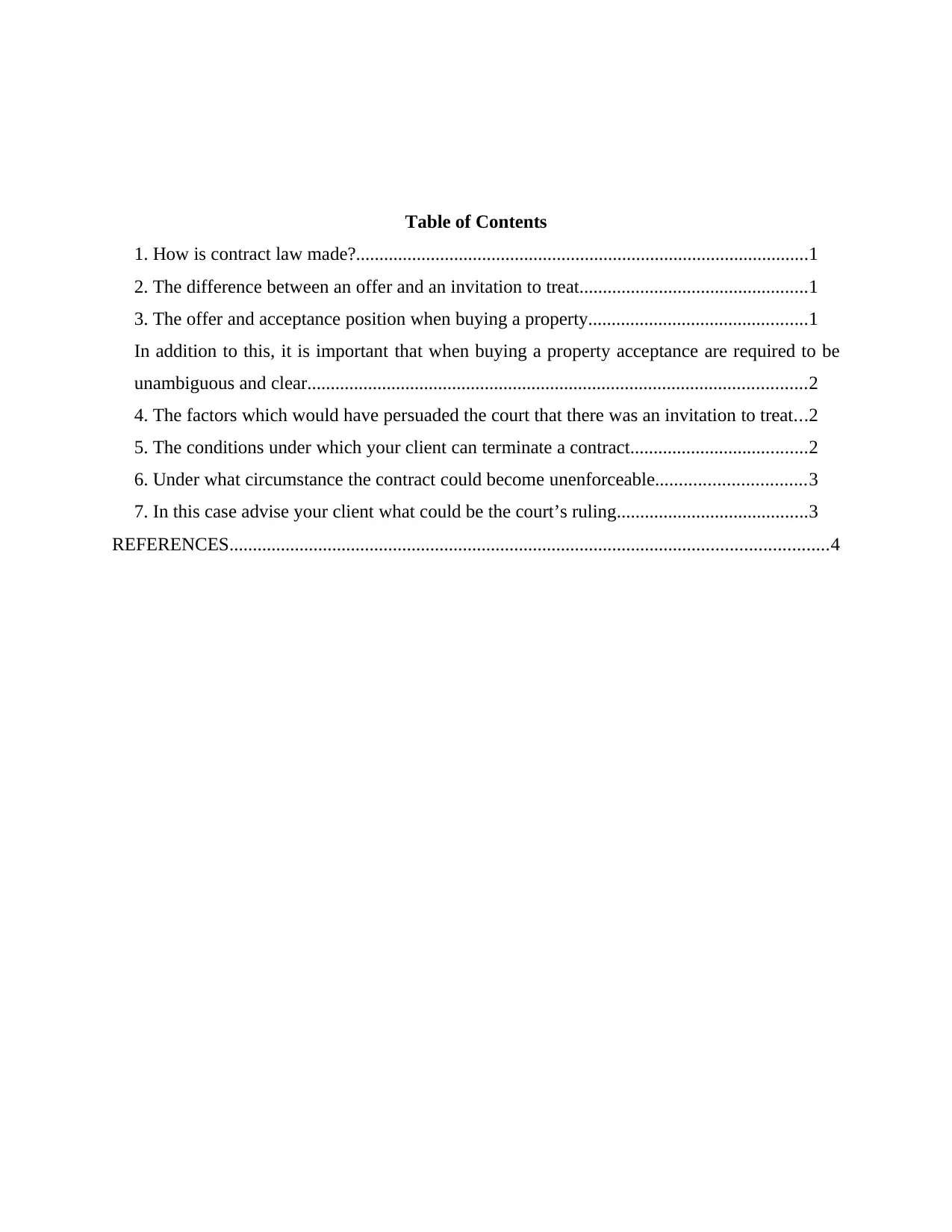
Table of Contents
1. How is contract law made?.................................................................................................1
2. The difference between an offer and an invitation to treat.................................................1
3. The offer and acceptance position when buying a property...............................................1
In addition to this, it is important that when buying a property acceptance are required to be
unambiguous and clear...........................................................................................................2
4. The factors which would have persuaded the court that there was an invitation to treat...2
5. The conditions under which your client can terminate a contract......................................2
6. Under what circumstance the contract could become unenforceable................................3
7. In this case advise your client what could be the court’s ruling.........................................3
REFERENCES................................................................................................................................4
1. How is contract law made?.................................................................................................1
2. The difference between an offer and an invitation to treat.................................................1
3. The offer and acceptance position when buying a property...............................................1
In addition to this, it is important that when buying a property acceptance are required to be
unambiguous and clear...........................................................................................................2
4. The factors which would have persuaded the court that there was an invitation to treat...2
5. The conditions under which your client can terminate a contract......................................2
6. Under what circumstance the contract could become unenforceable................................3
7. In this case advise your client what could be the court’s ruling.........................................3
REFERENCES................................................................................................................................4
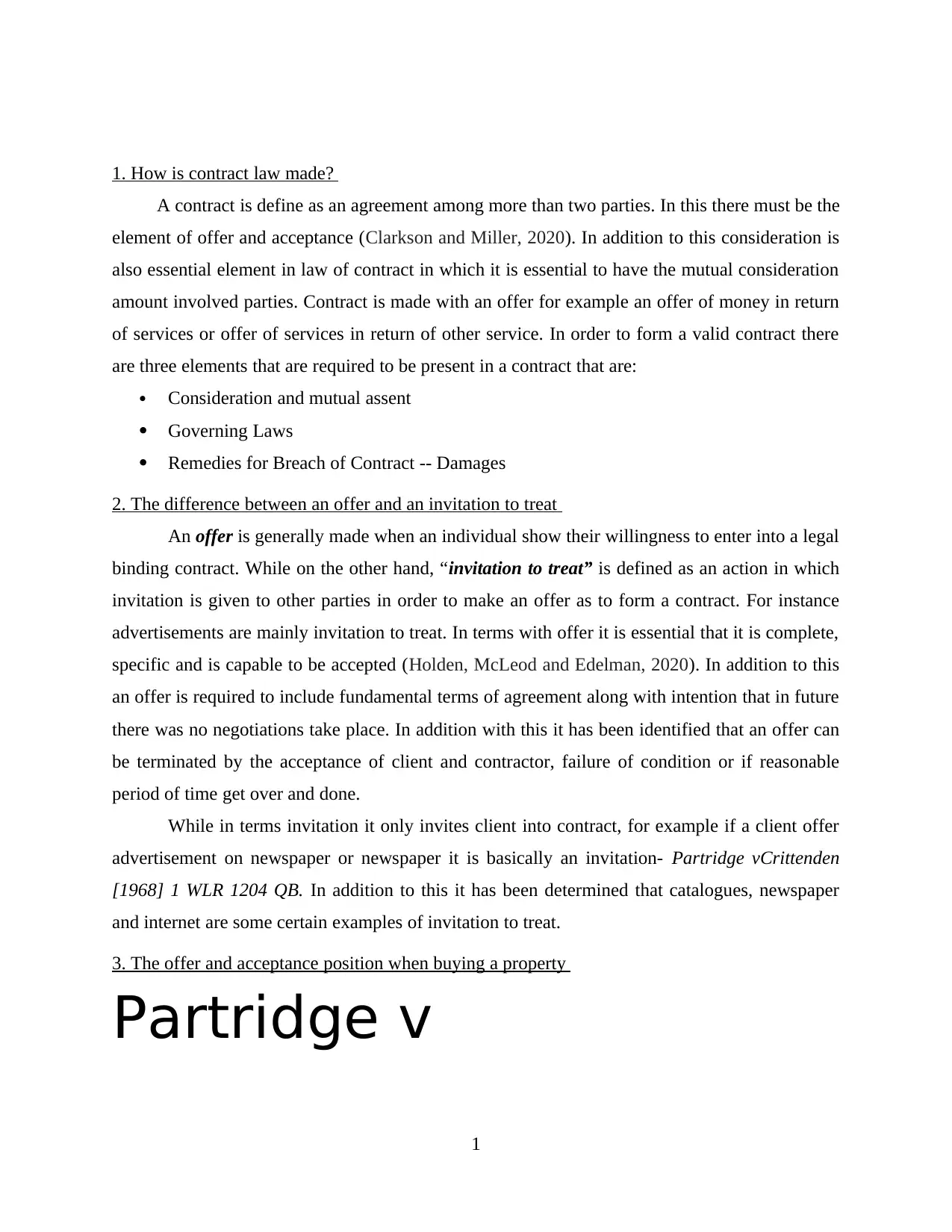
1. How is contract law made?
A contract is define as an agreement among more than two parties. In this there must be the
element of offer and acceptance (Clarkson and Miller, 2020). In addition to this consideration is
also essential element in law of contract in which it is essential to have the mutual consideration
amount involved parties. Contract is made with an offer for example an offer of money in return
of services or offer of services in return of other service. In order to form a valid contract there
are three elements that are required to be present in a contract that are:
Consideration and mutual assent
Governing Laws
Remedies for Breach of Contract -- Damages
2. The difference between an offer and an invitation to treat
An offer is generally made when an individual show their willingness to enter into a legal
binding contract. While on the other hand, “invitation to treat” is defined as an action in which
invitation is given to other parties in order to make an offer as to form a contract. For instance
advertisements are mainly invitation to treat. In terms with offer it is essential that it is complete,
specific and is capable to be accepted (Holden, McLeod and Edelman, 2020). In addition to this
an offer is required to include fundamental terms of agreement along with intention that in future
there was no negotiations take place. In addition with this it has been identified that an offer can
be terminated by the acceptance of client and contractor, failure of condition or if reasonable
period of time get over and done.
While in terms invitation it only invites client into contract, for example if a client offer
advertisement on newspaper or newspaper it is basically an invitation- Partridge vCrittenden
[1968] 1 WLR 1204 QB. In addition to this it has been determined that catalogues, newspaper
and internet are some certain examples of invitation to treat.
3. The offer and acceptance position when buying a property
Partridge v
1
A contract is define as an agreement among more than two parties. In this there must be the
element of offer and acceptance (Clarkson and Miller, 2020). In addition to this consideration is
also essential element in law of contract in which it is essential to have the mutual consideration
amount involved parties. Contract is made with an offer for example an offer of money in return
of services or offer of services in return of other service. In order to form a valid contract there
are three elements that are required to be present in a contract that are:
Consideration and mutual assent
Governing Laws
Remedies for Breach of Contract -- Damages
2. The difference between an offer and an invitation to treat
An offer is generally made when an individual show their willingness to enter into a legal
binding contract. While on the other hand, “invitation to treat” is defined as an action in which
invitation is given to other parties in order to make an offer as to form a contract. For instance
advertisements are mainly invitation to treat. In terms with offer it is essential that it is complete,
specific and is capable to be accepted (Holden, McLeod and Edelman, 2020). In addition to this
an offer is required to include fundamental terms of agreement along with intention that in future
there was no negotiations take place. In addition with this it has been identified that an offer can
be terminated by the acceptance of client and contractor, failure of condition or if reasonable
period of time get over and done.
While in terms invitation it only invites client into contract, for example if a client offer
advertisement on newspaper or newspaper it is basically an invitation- Partridge vCrittenden
[1968] 1 WLR 1204 QB. In addition to this it has been determined that catalogues, newspaper
and internet are some certain examples of invitation to treat.
3. The offer and acceptance position when buying a property
Partridge v
1
⊘ This is a preview!⊘
Do you want full access?
Subscribe today to unlock all pages.

Trusted by 1+ million students worldwide
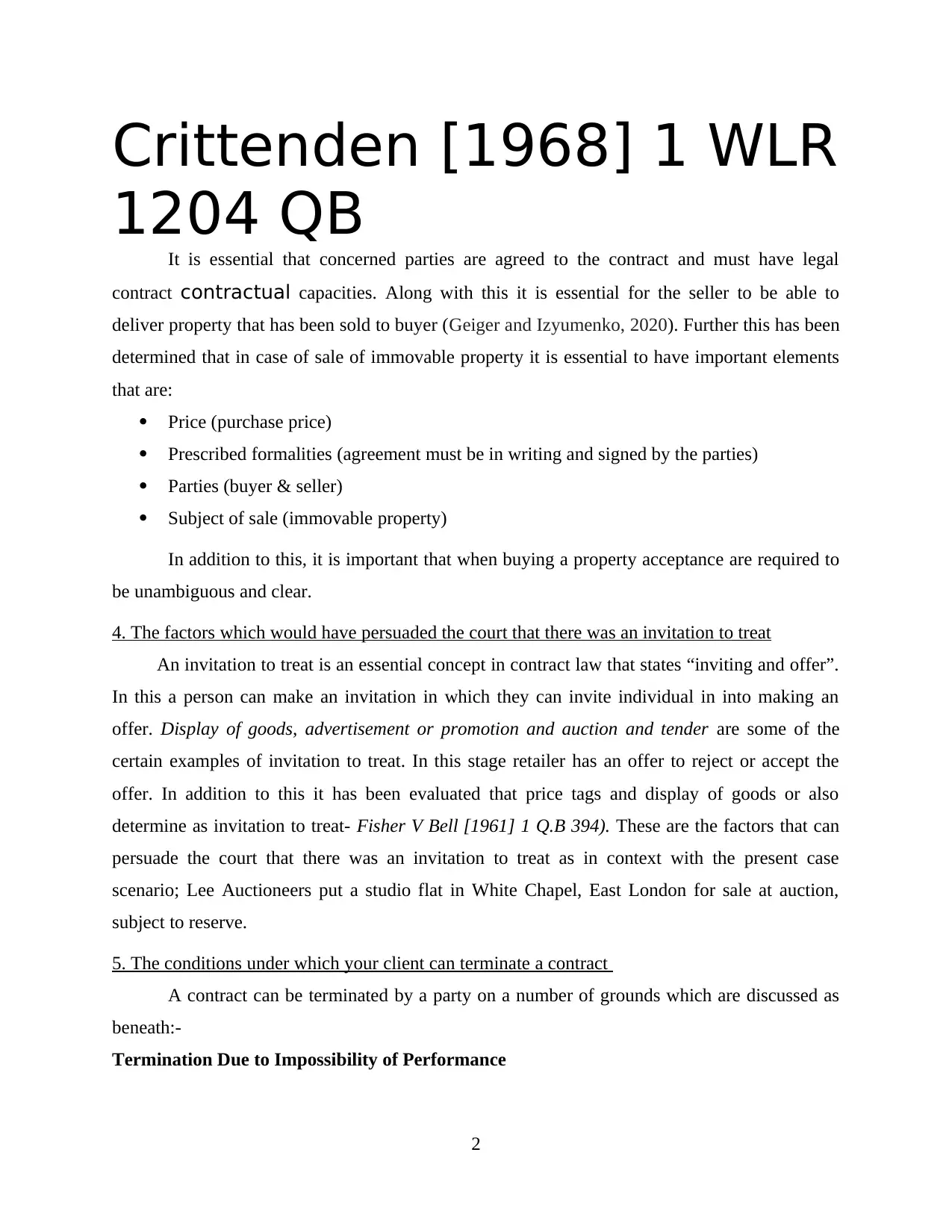
Crittenden [1968] 1 WLR
1204 QB
It is essential that concerned parties are agreed to the contract and must have legal
contract contractual capacities. Along with this it is essential for the seller to be able to
deliver property that has been sold to buyer (Geiger and Izyumenko, 2020). Further this has been
determined that in case of sale of immovable property it is essential to have important elements
that are:
Price (purchase price)
Prescribed formalities (agreement must be in writing and signed by the parties)
Parties (buyer & seller)
Subject of sale (immovable property)
In addition to this, it is important that when buying a property acceptance are required to
be unambiguous and clear.
4. The factors which would have persuaded the court that there was an invitation to treat
An invitation to treat is an essential concept in contract law that states “inviting and offer”.
In this a person can make an invitation in which they can invite individual in into making an
offer. Display of goods, advertisement or promotion and auction and tender are some of the
certain examples of invitation to treat. In this stage retailer has an offer to reject or accept the
offer. In addition to this it has been evaluated that price tags and display of goods or also
determine as invitation to treat- Fisher V Bell [1961] 1 Q.B 394). These are the factors that can
persuade the court that there was an invitation to treat as in context with the present case
scenario; Lee Auctioneers put a studio flat in White Chapel, East London for sale at auction,
subject to reserve.
5. The conditions under which your client can terminate a contract
A contract can be terminated by a party on a number of grounds which are discussed as
beneath:-
Termination Due to Impossibility of Performance
2
1204 QB
It is essential that concerned parties are agreed to the contract and must have legal
contract contractual capacities. Along with this it is essential for the seller to be able to
deliver property that has been sold to buyer (Geiger and Izyumenko, 2020). Further this has been
determined that in case of sale of immovable property it is essential to have important elements
that are:
Price (purchase price)
Prescribed formalities (agreement must be in writing and signed by the parties)
Parties (buyer & seller)
Subject of sale (immovable property)
In addition to this, it is important that when buying a property acceptance are required to
be unambiguous and clear.
4. The factors which would have persuaded the court that there was an invitation to treat
An invitation to treat is an essential concept in contract law that states “inviting and offer”.
In this a person can make an invitation in which they can invite individual in into making an
offer. Display of goods, advertisement or promotion and auction and tender are some of the
certain examples of invitation to treat. In this stage retailer has an offer to reject or accept the
offer. In addition to this it has been evaluated that price tags and display of goods or also
determine as invitation to treat- Fisher V Bell [1961] 1 Q.B 394). These are the factors that can
persuade the court that there was an invitation to treat as in context with the present case
scenario; Lee Auctioneers put a studio flat in White Chapel, East London for sale at auction,
subject to reserve.
5. The conditions under which your client can terminate a contract
A contract can be terminated by a party on a number of grounds which are discussed as
beneath:-
Termination Due to Impossibility of Performance
2
Paraphrase This Document
Need a fresh take? Get an instant paraphrase of this document with our AI Paraphraser
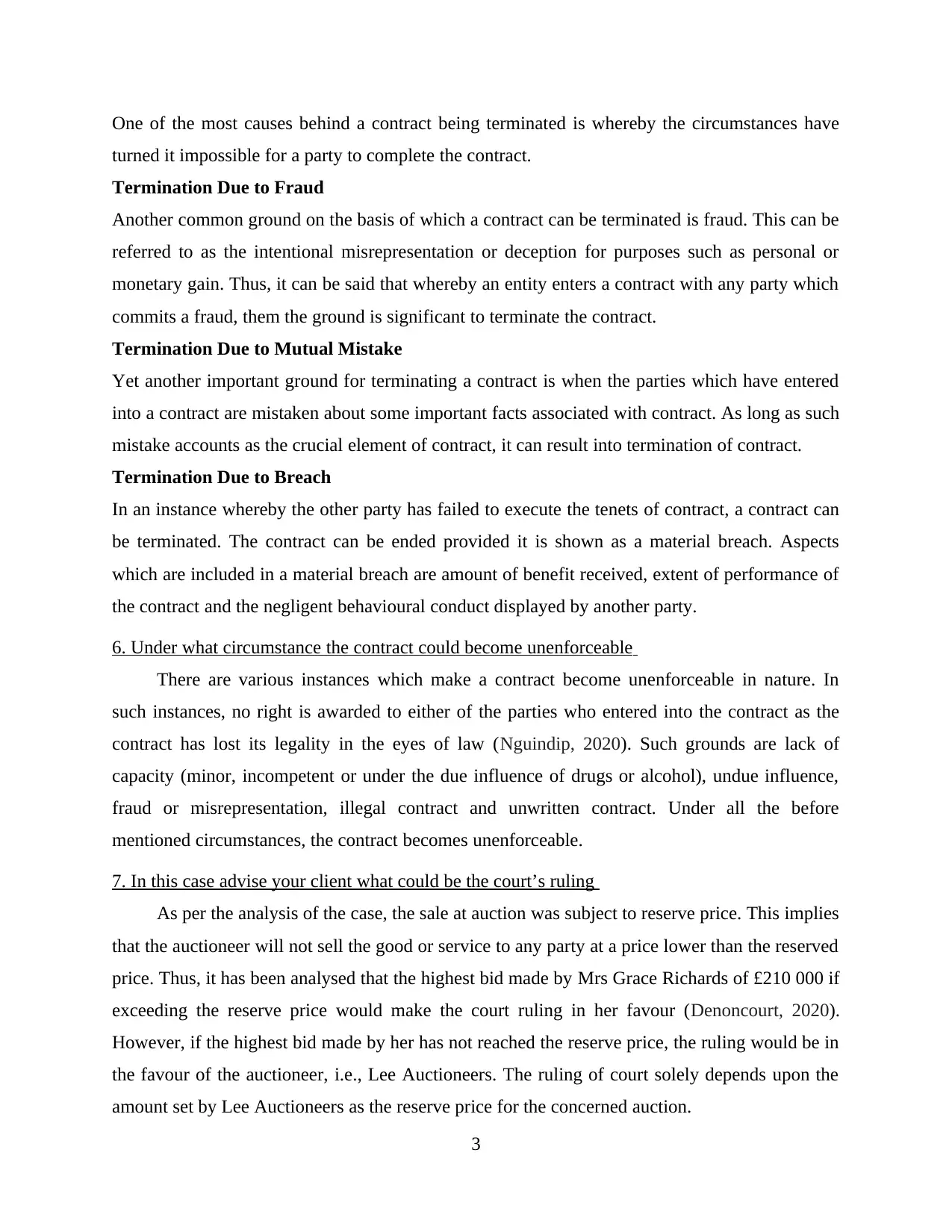
One of the most causes behind a contract being terminated is whereby the circumstances have
turned it impossible for a party to complete the contract.
Termination Due to Fraud
Another common ground on the basis of which a contract can be terminated is fraud. This can be
referred to as the intentional misrepresentation or deception for purposes such as personal or
monetary gain. Thus, it can be said that whereby an entity enters a contract with any party which
commits a fraud, them the ground is significant to terminate the contract.
Termination Due to Mutual Mistake
Yet another important ground for terminating a contract is when the parties which have entered
into a contract are mistaken about some important facts associated with contract. As long as such
mistake accounts as the crucial element of contract, it can result into termination of contract.
Termination Due to Breach
In an instance whereby the other party has failed to execute the tenets of contract, a contract can
be terminated. The contract can be ended provided it is shown as a material breach. Aspects
which are included in a material breach are amount of benefit received, extent of performance of
the contract and the negligent behavioural conduct displayed by another party.
6. Under what circumstance the contract could become unenforceable
There are various instances which make a contract become unenforceable in nature. In
such instances, no right is awarded to either of the parties who entered into the contract as the
contract has lost its legality in the eyes of law (Nguindip, 2020). Such grounds are lack of
capacity (minor, incompetent or under the due influence of drugs or alcohol), undue influence,
fraud or misrepresentation, illegal contract and unwritten contract. Under all the before
mentioned circumstances, the contract becomes unenforceable.
7. In this case advise your client what could be the court’s ruling
As per the analysis of the case, the sale at auction was subject to reserve price. This implies
that the auctioneer will not sell the good or service to any party at a price lower than the reserved
price. Thus, it has been analysed that the highest bid made by Mrs Grace Richards of £210 000 if
exceeding the reserve price would make the court ruling in her favour (Denoncourt, 2020).
However, if the highest bid made by her has not reached the reserve price, the ruling would be in
the favour of the auctioneer, i.e., Lee Auctioneers. The ruling of court solely depends upon the
amount set by Lee Auctioneers as the reserve price for the concerned auction.
3
turned it impossible for a party to complete the contract.
Termination Due to Fraud
Another common ground on the basis of which a contract can be terminated is fraud. This can be
referred to as the intentional misrepresentation or deception for purposes such as personal or
monetary gain. Thus, it can be said that whereby an entity enters a contract with any party which
commits a fraud, them the ground is significant to terminate the contract.
Termination Due to Mutual Mistake
Yet another important ground for terminating a contract is when the parties which have entered
into a contract are mistaken about some important facts associated with contract. As long as such
mistake accounts as the crucial element of contract, it can result into termination of contract.
Termination Due to Breach
In an instance whereby the other party has failed to execute the tenets of contract, a contract can
be terminated. The contract can be ended provided it is shown as a material breach. Aspects
which are included in a material breach are amount of benefit received, extent of performance of
the contract and the negligent behavioural conduct displayed by another party.
6. Under what circumstance the contract could become unenforceable
There are various instances which make a contract become unenforceable in nature. In
such instances, no right is awarded to either of the parties who entered into the contract as the
contract has lost its legality in the eyes of law (Nguindip, 2020). Such grounds are lack of
capacity (minor, incompetent or under the due influence of drugs or alcohol), undue influence,
fraud or misrepresentation, illegal contract and unwritten contract. Under all the before
mentioned circumstances, the contract becomes unenforceable.
7. In this case advise your client what could be the court’s ruling
As per the analysis of the case, the sale at auction was subject to reserve price. This implies
that the auctioneer will not sell the good or service to any party at a price lower than the reserved
price. Thus, it has been analysed that the highest bid made by Mrs Grace Richards of £210 000 if
exceeding the reserve price would make the court ruling in her favour (Denoncourt, 2020).
However, if the highest bid made by her has not reached the reserve price, the ruling would be in
the favour of the auctioneer, i.e., Lee Auctioneers. The ruling of court solely depends upon the
amount set by Lee Auctioneers as the reserve price for the concerned auction.
3
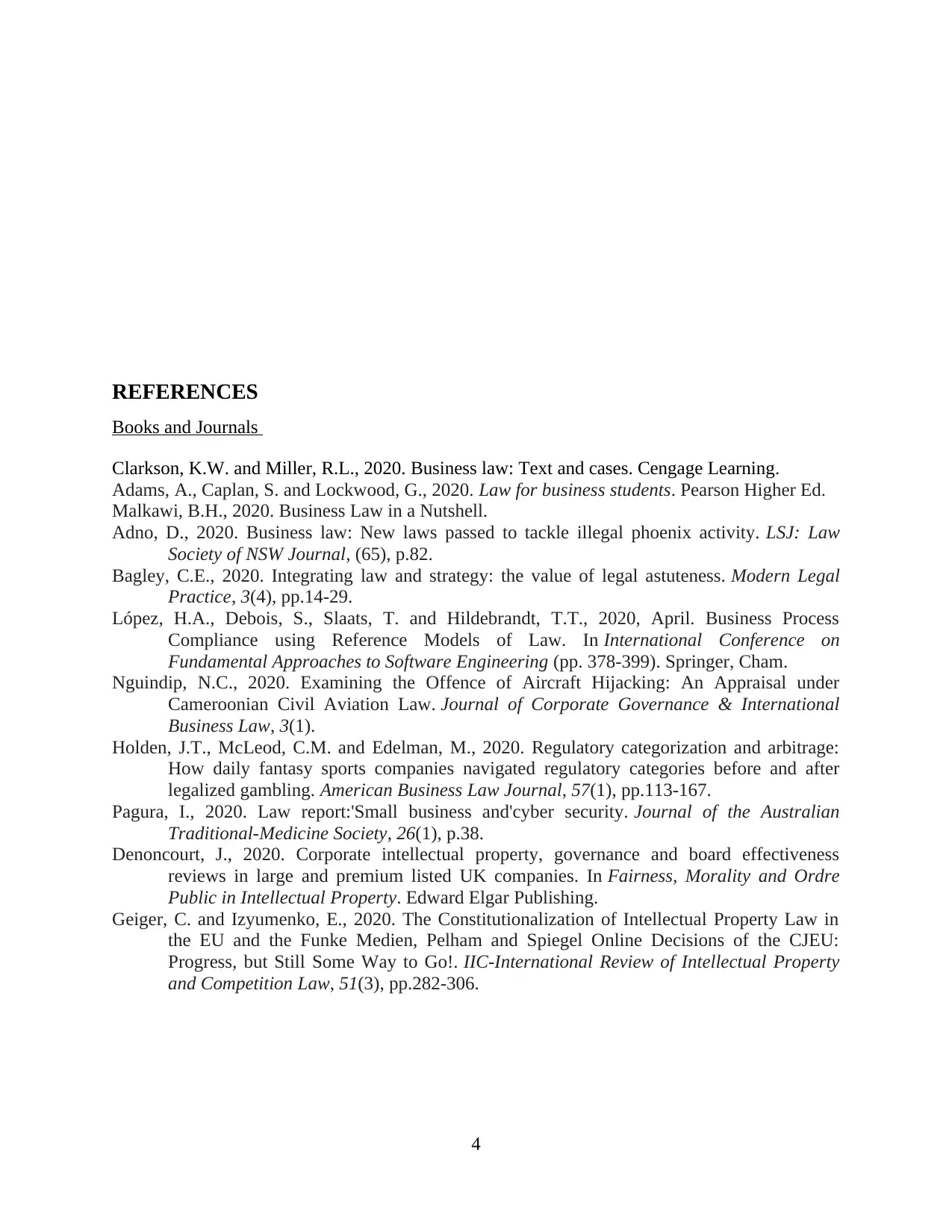
REFERENCES
Books and Journals
Clarkson, K.W. and Miller, R.L., 2020. Business law: Text and cases. Cengage Learning.
Adams, A., Caplan, S. and Lockwood, G., 2020. Law for business students. Pearson Higher Ed.
Malkawi, B.H., 2020. Business Law in a Nutshell.
Adno, D., 2020. Business law: New laws passed to tackle illegal phoenix activity. LSJ: Law
Society of NSW Journal, (65), p.82.
Bagley, C.E., 2020. Integrating law and strategy: the value of legal astuteness. Modern Legal
Practice, 3(4), pp.14-29.
López, H.A., Debois, S., Slaats, T. and Hildebrandt, T.T., 2020, April. Business Process
Compliance using Reference Models of Law. In International Conference on
Fundamental Approaches to Software Engineering (pp. 378-399). Springer, Cham.
Nguindip, N.C., 2020. Examining the Offence of Aircraft Hijacking: An Appraisal under
Cameroonian Civil Aviation Law. Journal of Corporate Governance & International
Business Law, 3(1).
Holden, J.T., McLeod, C.M. and Edelman, M., 2020. Regulatory categorization and arbitrage:
How daily fantasy sports companies navigated regulatory categories before and after
legalized gambling. American Business Law Journal, 57(1), pp.113-167.
Pagura, I., 2020. Law report:'Small business and'cyber security. Journal of the Australian
Traditional-Medicine Society, 26(1), p.38.
Denoncourt, J., 2020. Corporate intellectual property, governance and board effectiveness
reviews in large and premium listed UK companies. In Fairness, Morality and Ordre
Public in Intellectual Property. Edward Elgar Publishing.
Geiger, C. and Izyumenko, E., 2020. The Constitutionalization of Intellectual Property Law in
the EU and the Funke Medien, Pelham and Spiegel Online Decisions of the CJEU:
Progress, but Still Some Way to Go!. IIC-International Review of Intellectual Property
and Competition Law, 51(3), pp.282-306.
4
Books and Journals
Clarkson, K.W. and Miller, R.L., 2020. Business law: Text and cases. Cengage Learning.
Adams, A., Caplan, S. and Lockwood, G., 2020. Law for business students. Pearson Higher Ed.
Malkawi, B.H., 2020. Business Law in a Nutshell.
Adno, D., 2020. Business law: New laws passed to tackle illegal phoenix activity. LSJ: Law
Society of NSW Journal, (65), p.82.
Bagley, C.E., 2020. Integrating law and strategy: the value of legal astuteness. Modern Legal
Practice, 3(4), pp.14-29.
López, H.A., Debois, S., Slaats, T. and Hildebrandt, T.T., 2020, April. Business Process
Compliance using Reference Models of Law. In International Conference on
Fundamental Approaches to Software Engineering (pp. 378-399). Springer, Cham.
Nguindip, N.C., 2020. Examining the Offence of Aircraft Hijacking: An Appraisal under
Cameroonian Civil Aviation Law. Journal of Corporate Governance & International
Business Law, 3(1).
Holden, J.T., McLeod, C.M. and Edelman, M., 2020. Regulatory categorization and arbitrage:
How daily fantasy sports companies navigated regulatory categories before and after
legalized gambling. American Business Law Journal, 57(1), pp.113-167.
Pagura, I., 2020. Law report:'Small business and'cyber security. Journal of the Australian
Traditional-Medicine Society, 26(1), p.38.
Denoncourt, J., 2020. Corporate intellectual property, governance and board effectiveness
reviews in large and premium listed UK companies. In Fairness, Morality and Ordre
Public in Intellectual Property. Edward Elgar Publishing.
Geiger, C. and Izyumenko, E., 2020. The Constitutionalization of Intellectual Property Law in
the EU and the Funke Medien, Pelham and Spiegel Online Decisions of the CJEU:
Progress, but Still Some Way to Go!. IIC-International Review of Intellectual Property
and Competition Law, 51(3), pp.282-306.
4
⊘ This is a preview!⊘
Do you want full access?
Subscribe today to unlock all pages.

Trusted by 1+ million students worldwide
1 out of 6
Related Documents
Your All-in-One AI-Powered Toolkit for Academic Success.
+13062052269
info@desklib.com
Available 24*7 on WhatsApp / Email
![[object Object]](/_next/static/media/star-bottom.7253800d.svg)
Unlock your academic potential
Copyright © 2020–2025 A2Z Services. All Rights Reserved. Developed and managed by ZUCOL.




